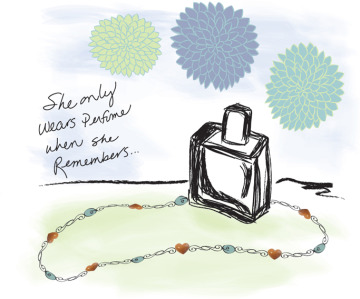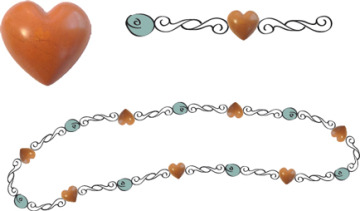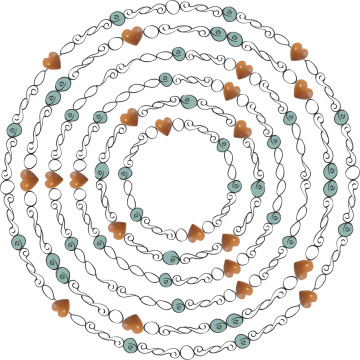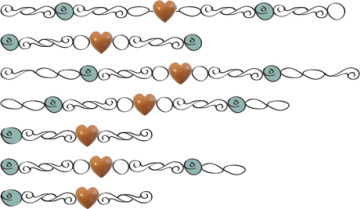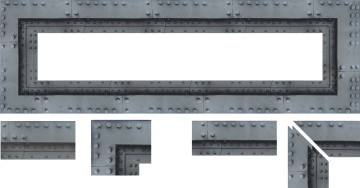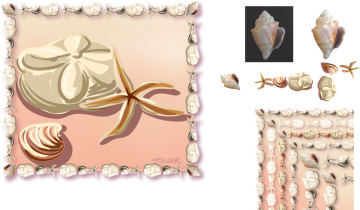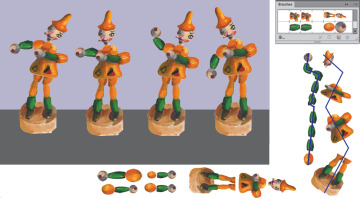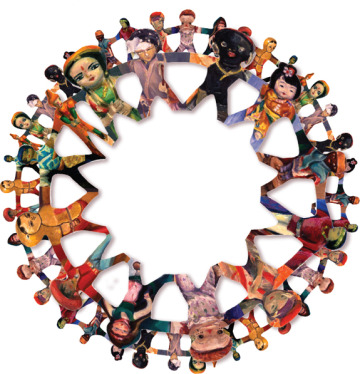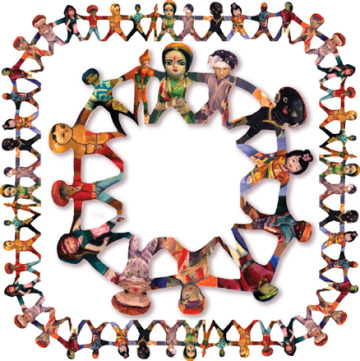- Width Tool And Stroke Profiles
- The Expanded Stroke Panel
- Brushes
- Symbols
- Dynamic Symbols, & New Raster Brushes in CC
- Stroke Variance
- Gallery: MCKIBILLO (AKA Josh McKible)
- Brushes & Washes
- Gallery: Stephen Klema’s Students: Jillian Winkel, Stephanie Pernal, Amber Loukoumis, Jeffrey Martin, Nicole Dzienis, Tamara Morrison
- Gallery: Sharon Steuer
- Painting Inside
- Painterly Portraits
- Gallery: Greg Geisler
- Pattern Brushes
- Gallery: Donal Jolley
- Brush Corners
- Gallery: Lisa Jackmore
Gallery: Lisa Jackmore

Lisa Jackmore created variations within her pattern brush using Variable Width Profile. She began by drawing the bottle, the text, one set of necklace links, and the blue bead with a Calligraphic brush and pressure-sensitive pen and tablet. For the heart bead she scanned a stone and then masked it in Photoshop. Jackmore then placed the PNG image of the stone heart onto the artboard in Illustrator and then in the Control panel clicked the Embed link and scaled the image proportionally. Jackmore aligned the beaded elements to the heart, dragged them together into the Brushes panel, and selected Pattern brush, keeping all the default settings. Jackmore chose the Paintbrush tool, made a circular path, and clicked the Pattern brush to apply it to the path. To suggest perspective and slightly vary bead size, she selected the path, switched to the Width tool, and then selected several points. She held the Shift key down while dragging one point to uniformly modify the width. She continued until the beads looked as though they were lying flat, with some of the hearts slightly larger than others. She saved the profile by clicking the Add to Profile icon in the Variable Width Profile menu in the Control panel. With her main elements in place, Jackmore added background color with a bristle brush and the text and flowers with a calligraphic brush. Having saved the profile in the application settings, she now has access to this custom profile to apply to paths of any type, including brushes. Jackmore created several variations of the pattern brush that she can now substitute for the original; you can see some on the opposite page.
Gallery: Lisa Jackmore

With just a few adjustments to her designs, Lisa Jackmore was able to very quickly make variations to her pattern brushes. Shown at right are several pattern brush variations created for the opposite page, which are then applied to circle paths above.
Gallery: Lisa Jackmore

Lisa Jackmore found inspiration for this Pattern Brush in a steel-beamed ceiling. She saved a raster image detail of the beam as a PNG image (above left) in Photoshop and then opened it in Illustrator. Jackmore dragged the embedded image to the Brushes panel and selected Pattern Brush in the New Brush dialog. In Pattern Brush Options she kept the default scale and spacing. She only needed Outer Corners for a frame, so for this pattern she chose Auto-Sliced and Approximate Path, named it, and clicked OK. She made and selected a rectangle and then clicked the pattern brush in the Brushes panel and applied the brush. Jackmore was aiming for a seamless pattern that didn’t distort the image; this attempt was pretty close, but not quite perfect (directly above right). Jackmore felt she needed to tweak the pattern brush slightly so the dark seam, rivets, and bolts were better aligned and not cut off. To solve the puzzle about why her pattern repeat wasn’t working perfectly, she dragged the brush from the Brushes panel onto her artboard to examine more closely how the parts fit together. An Auto-Sliced corner tile is made of two objects overlapping each other, within an unstroked, unfilled rectangle defining the corner parameters. To adjust the Corner tile, Jackmore selected one image object at a time and used the arrow keys to move it within the tile until she figured out how to solve her problem. She then went back to Photoshop and made adjustments to the original image, including deleting one of the bolts, enlarging the ends of the image to extend the bolt-free area, and adjusting the dark seam on one side to align evenly with the opposite side (directly above left). Once she thought the right changes were made, she brought the image back into Illustrator and created a new pattern brush. Because the image was complex, Jackmore had to make a few more trips to Photoshop and then back to Illustrator to make new brushes with her tiles to finally achieve the perfect image, and in the end the Auto-Corners worked perfectly (above right shown pulled apart).
Gallery: Sharon Steuer

Borrowing elements from Illustrator art she created several years earlier, Sharon Steuer reinvigorated the original calligraphic brush work with the addition of a frame made with a pattern brush, invoking the look of a craft frame made by children on a beach vacation. Steuer duplicated, scaled, and rearranged the shells and starfish. Dragging them into the Brushes panel, she chose Pattern Brush, enabled Stretch to fit (under Fit), chose Tints and Hues as the Colorization Method, and clicked OK. For the corner, she decided to use a photograph of a real shell. After masking the photo in Photoshop, she placed it as an embedded image in Illustrator. To add the photo as a corner tile to the pattern brush, she selected the masked shell and then—with the Brushes panel in Thumbnail view—held Option/Alt as she dragged the photo to the far left “tile space” of the shell pattern brush. Checking that her settings were still correct, she clicked OK. After applying the brush to a rectangle to form a frame, she didn’t like the position of the photo. To figure out how to reposition the shell, she used the frame on the artboard as a reference and positioned a copy of the masked shell photo over the original corner of the frame, rotating it into the desired position. Holding down the Option/Alt key, Steuer dragged the rotated shell onto the previous corner tile in the Brushes panel, retaining the other options. To make pattern brush variations, she worked with duplicates of the original pattern brush, changing the Stroke weight in the Control panel and playing with different colorization methods in Brushes Options. To apply the color to vector objects of the pattern brush, she changed the Stroke color. To apply a shadow to the frame she selected Stroke in the Appearance panel, clicked the fx icon and then selected Stylize> Drop Shadow. Some of the color and scale experiments are shown above right.
Gallery: Sharon Steuer
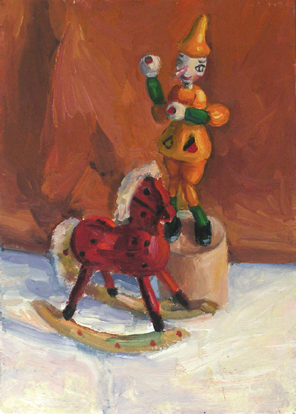
After discovering that she could paint with raster images in Illustrator, Sharon Steuer decided to experiment with making a pattern brush from an Italian “push puppet” in her oil paintings (one shown at right). In Photoshop she combined a number of details from different paintings in the series to form the pieces necessary to articulate three separate parts for the body (the legs and base, the torso, and the head), and three more so she could articulate the joints of an arm (one for each end and one for the middle). Tightly masking and cropping each element, she saved them as a separate PNG files, and placed all of them as embedded objects into one Illustrator file. Rotating each of the elements so that all were oriented horizontally, she dragged the torso segment into the Brushes panel. Choosing the Pattern Brush, she clicked OK to enter and then OK to exit Options. With the panel set to Thumbnail view, she next held Option/Alt as she dragged the legs and base into the start tile position and then applied the brush to a path to check the scale and positioning of the segment. Steuer repeated this process with the head in the end tile and then similarly created the arm brush in three stages. Using the Pen tool, she drew with the body pattern brush and then with the arm brush. If she’s careful about the path length and angles, she can position her puppet with nuance, or she can accidentally create strange effects. For links to her “Artistic Painting with Illustrator” courses (one movie shows this brush) and a 7-day free trial link, go to sharonsteuer.com/lynda.
Gallery: Sharon Steuer

While preparing artwork for the pattern brush chapter in her lynda.com course “Artistic Painting with Illustrator: Object-Creation Brushes,” Sharon Steuer realized that not all patterns work well with corners. She decided to revisit an art piece she created many years ago in which she digitally wrapped a line of her doll paintings around circles. Now she could achieve the same result more easily by placing the “paper doll” image in Illustrator, making it into a pattern brush, wrapping the pattern brush around a circle. After adding a drop shadow and a second smaller stroke from fx in the Appearance panel (see the Reshaping Dimensions chapter for more on the Appearance panel), she then experimented with applying this pattern to a rectangle, but none of the Auto-corners looked good, and she couldn’t visualize a custom corner that would work regardless of the size of the rectangle. Steuer realized that she could eliminate corners entirely by applying her pattern to a rounded rectangle. In her “Simulating Corners” movie she demonstrated how to manually select and adjust the rectangle’s anchor points to tweak how the pattern wraps around the shape. Now, with Live Rectangles, this process is much easier. Simply create a rectangle using the Rectangle tool, or if you have a previously created rectangle, choose Object> Shape> Convert to Rectangle. If your pattern isn’t already applied, click Basic in the Control panel and choose your brush from the pop-up. Now, in the Control panel (from Shape) or in the Transform panel, click the arrows to adjust the Corner Radius field. What radius value you’ll prefer will vary depending on the pattern, rectangle size, and stroke weight (both versions above are 90 pt).
Gallery: Steven Gordon

Designing a photography gallery for his Adobe Portfolio website, Steven Gordon used a dynamic symbol to prototype variations of a camera icon for his webpage banner. He started the camera icon by selecting the Rounded Rectangle tool and drawing the body of a camera. Next, he drew a mountain and filled it with black. To trim the mountain to the camera body, he duplicated the camera body, selected the mountain object, and then used Pathfinder> Intersect (see the Rethinking Construction chapter for more on Pathfinders). Gordon then finished the artwork by drawing the lens, flash, and shutter button objects. To complete the icon, he selected the camera body and filled it with a blue gradient to represent the sky (see the Color Transitions chapter for more on gradients). To preserve his artwork, Gordon turned it into a graphic symbol. To do this, he selected the icon’s artwork and clicked the New Symbol icon in the Symbols panel. He made sure that Dynamic Symbol was enabled in the Symbol Options dialog so that he’d later be able to directly edit its colors, and then clicked OK; his artwork was now replaced with his new symbol. While building the webpage, Gordon decided to prototype several color variations of the icon, to see which worked best with different webpage color schemes. To do this, he chose the Direct Selection tool and clicked on the sky area of the icon. With the gradient now selected, Gordon opened the Gradient panel and experimented with different color gradients. As he made each version, he stored it as a new symbol before reviewing all the versions and choosing the one he added to the webpage banner. By storing different versions of his camera icons as symbols, Gordon was able to create a collection of icons that he could easily use to freshen the webpage in the future, perhaps switching to a new theme color or customizing the color of a particular page.

